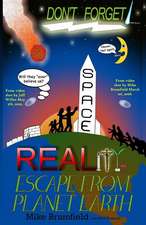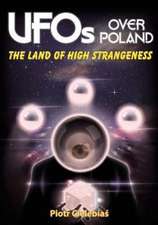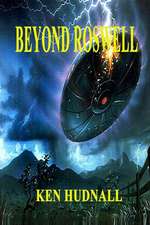Astrobiology, History, and Society: Life Beyond Earth and the Impact of Discovery: Advances in Astrobiology and Biogeophysics
Editat de Douglas A. Vakochen Limba Engleză Paperback – 8 feb 2015
The chapters are all written by internationally recognized experts and are carefully edited by Douglas Vakoch, professor of clinical psychology at the California Institute of Integral Studies and Director of Interstellar Message Composition at the SETI Institute.
This interdisciplinary book will benefit everybody trying to understand the meaning of astrobiology and SETI for our human society.
| Toate formatele și edițiile | Preț | Express |
|---|---|---|
| Paperback (1) | 1004.00 lei 6-8 săpt. | |
| Springer Berlin, Heidelberg – 8 feb 2015 | 1004.00 lei 6-8 săpt. | |
| Hardback (1) | 1008.12 lei 6-8 săpt. | |
| Springer Berlin, Heidelberg – 12 iun 2013 | 1008.12 lei 6-8 săpt. |
Preț: 1004.00 lei
Preț vechi: 1224.39 lei
-18% Nou
Puncte Express: 1506
Preț estimativ în valută:
192.13€ • 199.38$ • 160.59£
192.13€ • 199.38$ • 160.59£
Carte tipărită la comandă
Livrare economică 15-29 martie
Preluare comenzi: 021 569.72.76
Specificații
ISBN-13: 9783642435409
ISBN-10: 3642435408
Pagini: 404
Ilustrații: XXVIII, 375 p.
Dimensiuni: 155 x 235 x 21 mm
Greutate: 0.56 kg
Ediția:2013
Editura: Springer Berlin, Heidelberg
Colecția Springer
Seria Advances in Astrobiology and Biogeophysics
Locul publicării:Berlin, Heidelberg, Germany
ISBN-10: 3642435408
Pagini: 404
Ilustrații: XXVIII, 375 p.
Dimensiuni: 155 x 235 x 21 mm
Greutate: 0.56 kg
Ediția:2013
Editura: Springer Berlin, Heidelberg
Colecția Springer
Seria Advances in Astrobiology and Biogeophysics
Locul publicării:Berlin, Heidelberg, Germany
Public țintă
ResearchCuprins
Part I. The Early Extraterrestrial Life Debate.- Chapter 1. The Extraterrestrial Life Debate from Antiquity to 1900.- Chapter 2. Early Modern ET, Reflexive Telescopics, and Their Relevance Today.- Chapter 3. Extraterrestrial Life as the Great Analogy, Two Centuries Ago and in Modern Astrobiology.- Chapter 4. Hegel, Analogy, and Extraterrestrial Life.- Chapter 5. The Relationship Between the Origins of Life on Earth and the Possibility of Life on Other Planets: A Nineteenth-century Perspective.- Chapter 6. Pioneering Concepts of Planetary Habitability.- Part II. The Modern Extraterrestrial Life Debate.- Chapter 7. The Twentieth Century History of the Extraterrestrial Life Debate: Major Themes and Lessons Learned.- Chapter 8. The Creator of Astrobotany, Gavriil Adrianovich Tikhov.- Chapter 9. Life Beyond Earth and the Evolutionary Synthesis.- Chapter 10. The First Thousand Exoplanets: Two Decades of Excitement and Discovery.- Chapter 11. Extraterrestrial Life in the Microbial Age.- Part III. Societal Impact of Discovering Extraterrestrial Life.- Chapter 12. The Societal Impact of Extraterrestrial Life: The Relevance of History and the Social Sciences.- Chapter 13. Cultural Resources and Cognitive Frames: Keys to an Anthropological Approach to Prediction.- Chapter 14. The Detection of Extraterrestrial Life: Are We Ready?.- Chapter 15. Impact of Extraterrestrial Life Discovery for Third World Societies: Anthropological and Public Health Considerations.- Chapter 16. Impossible Predictions of the Unprecedented: Analogy, History, and the Work of Prognostication.- Chapter 17. Mainstream Media and Social Media Reactions to the Discovery of Extraterrestrial Life.- Chapter 18. Christianity’s Response to the Discovery of Extraterrestrial Intelligent Life: Insights from Science and Religion and the Sociology of Religion.- Chapter 19. Would the Discovery of ETI Provoke a Religious Crisis?.- Index.
Recenzii
Selected by Choice magazine as an "Outstanding Academic Title" for 2014
“This book is a very well-balanced, detailed analysis of the subject. … This is one of the best books on the subject; it belongs in all college libraries. Summing Up: Essential. All levels/libraries.” (K. L. Schick, Choice, Vol. 51 (7), March, 2014)
“Are we alone in the universe? If not, then what might that mean? This fascinating volume offers a history of what Western cultures have thought about these questions … . a useful source for scientists, historians, anthropologists, and many other disciplines that concern themselves with these two large questions. … This volume nicely reveals the numerous ways in which anthropological knowledge and methods can help us think about and plan for managing the cultural impact of an eventual first contact.” (James Strick, Journal for the History of Astronomy, Vol. 47 (1), 2016)
“In this book you can find out about the first philosophers, writers and scientists who were interested in the possibility of life on other planets and get to know the reasons why it was considered possible by them and what actually led to their depictions of life elsewhere in literature. … Overall this book makes for really interesting reading if you’re interested in extraterrestrial life and astrobiology.” (Kadri Tinn, AstroMadness.com, December, 2013)
“This book is a very well-balanced, detailed analysis of the subject. … This is one of the best books on the subject; it belongs in all college libraries. Summing Up: Essential. All levels/libraries.” (K. L. Schick, Choice, Vol. 51 (7), March, 2014)
“Are we alone in the universe? If not, then what might that mean? This fascinating volume offers a history of what Western cultures have thought about these questions … . a useful source for scientists, historians, anthropologists, and many other disciplines that concern themselves with these two large questions. … This volume nicely reveals the numerous ways in which anthropological knowledge and methods can help us think about and plan for managing the cultural impact of an eventual first contact.” (James Strick, Journal for the History of Astronomy, Vol. 47 (1), 2016)
“In this book you can find out about the first philosophers, writers and scientists who were interested in the possibility of life on other planets and get to know the reasons why it was considered possible by them and what actually led to their depictions of life elsewhere in literature. … Overall this book makes for really interesting reading if you’re interested in extraterrestrial life and astrobiology.” (Kadri Tinn, AstroMadness.com, December, 2013)
Textul de pe ultima copertă
This book addresses important current and historical topics in astrobiology and the search for life beyond Earth, including the search for extraterrestrial intelligence (SETI). The first section covers the plurality of worlds debate from antiquity through the nineteenth century, while section two covers the extraterrestrial life debate from the twentieth century to the present. The final section examines the societal impact of discovering life beyond Earth, including both cultural and religious dimensions. Throughout the book, authors draw links between their own chapters and those of other contributors, emphasizing the interconnections between the various strands of the history and societal impact of the search for extraterrestrial life.
The chapters are all written by internationally recognized experts and are carefully edited by Douglas Vakoch, professor of clinical psychology at the California Institute of Integral Studies and Director of Interstellar Message Composition at the SETI Institute.
This interdisciplinary book will benefit everybody trying to understand the meaning of astrobiology and SETI for our human society.
The chapters are all written by internationally recognized experts and are carefully edited by Douglas Vakoch, professor of clinical psychology at the California Institute of Integral Studies and Director of Interstellar Message Composition at the SETI Institute.
This interdisciplinary book will benefit everybody trying to understand the meaning of astrobiology and SETI for our human society.
Caracteristici
Presents essays exploring the societal, anthropological, and religious dimensions of astrobiology and SETI Offers a comprehensive overview of the extraterrestrial life debate from antiquity to the present day Demonstrates possible impacts of the discovery of extraterrestrial life on human society Explores the importance of analogies for contemporary astrobiologists, who search for life beyond Earth based on terrestrial life and environments Provides insights into the nature of scientific discovery through in-depth case studies




































